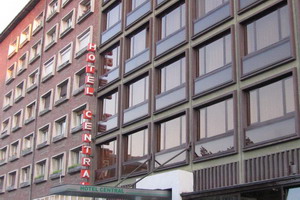
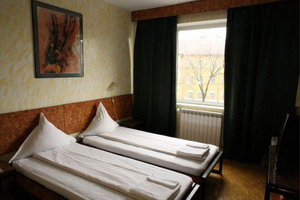
Banatfolk
Romanian Folk Dance Seminar
Organized by Marius Ursu
The 14th edition
Timisoara, Romania
4th – 14th of July 2017
Come Join Us for 10 Memorable Days of Music, Dance, More ...
... in beautiful Timisoara, the
capital of Banat, a town in the west part of Romania, also known as the town
of roses.
Timisoara it was the first mainland European city to be lit by electric street
lamps in 1884. It was also the second European and the first city in what is
now Romania with horse drawn trams in 1867. Gustave Eiffel, the creator of the
Eiffel Tower in Paris, drew the projects of one of Timisoara’s footbridges
over the Bega. On December 20, 1989 was proclaimed the first city free of communism
in Romania.
The Seminar
Program includes:
Dance Lessons Maria and Marius
Ursu, also master choreographers of the groups that will participate in The
International Folk Festival “Festivalul Inimilor”
Watching the performances from The International
Folk Festival “Festivalul Inimilor” (folk groups from 10 countries
and more than 20 folk groups from Romania will take part: professional and from
villages
Excursions to explore the beauty, rich history,
and living traditions of Transylvania
We have a surprise for you:
We will prepare a choreographic suite from Banat, which
we will present the closing show of The International Folk Festival “Festivalul
Inimilor”
Plus ... Full Board, double
accommodations in hotels and peasants' homes, cultural activities, excursions
and transportation to all seminar activities. Single accommodation is available
with surcharge.
Price:
• 780 euro. The fee includes the participation in
all the activities mentioned above, the transfer from the Timisoara International
Airport to the hotel
• 580 euro/person, for the persons that do not take part in the courses
but take part in the other activities.
An additional 200 euro is required for a single room.
Schedule
Tuesday, July 4th, 2017
Transfer from the International Airport of Timisoara to hotel Central.
Hotel Central is located right in the heart of Timisoara,
next to the Huniade Castle, and offers you air-conditioned accommodation with
modern furniture and free Wi-Fi.
It has a restaurant serving typical Romanian and international cuisine.
http://www.booking.com/hotel/ro/central-timisoara.html
 |
 |
19,30 – 21,30 Dinner. Show with folk ensemble "Doina Timisului".
 |
 |
Wednesday, July 5th, 2017
08,30 – 09,30 Breakfast
10,00 – 12,30 Folk dance workshop
13,00 – 14,00 Lunch
15,00 – 17,00 Folk dance workshop
18,00 – 19,00 Dinner
19,00 – 23,00 Attending the extraordinary folk performance by the folk
ensemble “Timisul”
 |
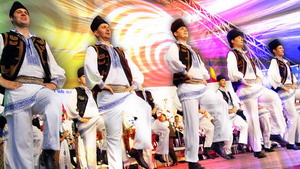 |
Thursday, July 6th, 2017
08,30 – 09,30 Breakfast
10,00 – 12,30 Folk dance workshop
13,00 – 14,00 Lunch
15,00 – 17,00 Folk dance workshop
18,00 – Watching the Costume Parade of the groups taking part in the Festival
of Hearts, followed by the Opening Ceremony
18,30 – 19,30 Dinner ( where the Festival takes place )
19,30 – 23,00 Attending the performances of the "The Festival of
Hearts” ( Festival stage located in the Park of the Roses)
 |
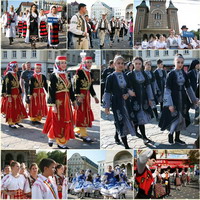 |
Friday, July 7th, 2017
08,30 – 09,30 Breakfast
10,00 – 12,30 Folk dance workshop
13,00 – 14,00 Lunch
15,00 – 17,00 Folk dance workshop
18,00 – 19,00 Dinner
19,00 – 23,00 Attending the performances of "The Festival of Hearts”
Saturday, July 8th, 2017
08,30 – 09,30 Breakfast
10,00 – 12,30 Folk workshop
13,30 – 14,30 Lunch
18,00 – 19,00 Dinner
19,00 – 23,00 Attending the performances of "The Festival of Hearts”
Sunday, July 9th, 2017
08,30 – 09,30 Breakfast
11,00 – 14,00 Visit to the Banat Village Museum
Banat Village Museum manages to
make a thumbnail of Banat villages by building authentic wood, stone and clay
houses made after the local model. Tourists attracted by the Banat culture can
find household items used in the past centuries, can admire the architecture
of the houses. These, though with 2 or 3 rooms, attract attention with guest
rooms, known as "clean stove," big stove", being the most beautiful
furnished and decorated with precious fabrics - towels, rugs, tablecloths once
called "masaie".
http://www.muzeulsatuluibanatean.ro/
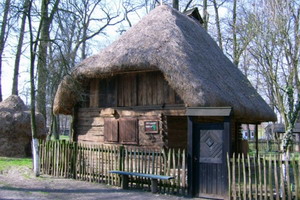 |
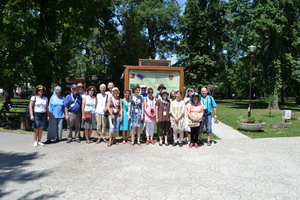 |
14,00 – 15,00 Lunch
16,00 – 17,00 Rehearsal of the choreography to be performed on the Festival
stage
18,00 – 19,00 Dinner
20,00 – 22,00 Closing performance of "The Festival of Hearts”
including performance of the choreographic suite learnt at the Seminar classes
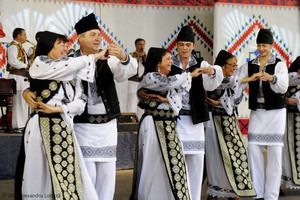 |
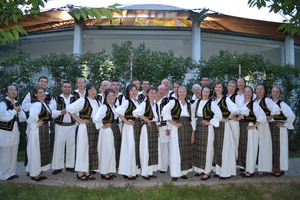 |
Folk
trip to Transylvania
Monday, July 10th,
2017
07.30 – 08.00 Breakfast
08.30 Departure to Hunedoara
Visit the Corvins’ Castle
13.00 – 14.00 Lunch
Visit the Deva Fortress
20.00 – 22,00 Dinner and dancing. Show with folk ensemble from Deva.
Corvin Castle,
also known as Hunyadi Castle or Hunedoara Castle (Romanian: Castelul Huniazilor
or Castelul Corvinilor; Hungarian: Vajdahunyadi vár), is a Gothic-Renaissance
castle in Hunedoara, Romania. It is one of the largest castles in Europe and
figures in a top of seven wonders of Romania.
Corvin Castle was laid out in 1446, when construction began at the orders of
John Hunyadi (Hungarian: Hunyadi János,Romanian: Iancu or Ioan de Hunedoara)
who wanted to transform the former keep built by Charles I of Hungary. The castle
was originally given to John Hunyadi's father, Voyk (Vajk), by Sigismund, king
of Hungary, as severance in 1409. It was also in 1446 when John Hunyadi was
elected as the regent-governor of the Kingdom of Hungary by the Diet.
The castle has 3 large areas: the Knight's Hall, the Diet Hall and the circular
stairway. The halls are rectangular in shape and are decorated with marble.
The Diet Hall was used for ceremonies or formal receptions whilst the Knight's
Hall was used for feasts. In 1456, John Hunyadi died and work on the castle
has stagnated. Starting with 1458, new commissions were being undergone to construct
the Matia Wing of the castle. In 1480, work was completely stopped on the castle
and it was recognised as being one of the biggest and most impressive buildings
in Eastern Europe.
https://en.wikipedia.org/wiki/Corvin_Castle
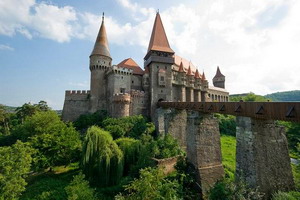 |
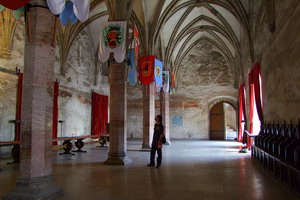 |
The Fortress of Deva
(Romanian: Cetatea Devei, Hungarian: Déva vára) is a fortress
located in the city of Deva, Hunedoara County, Romania, on top of a volcanic
hill.The first evidence of the medieval Deva Fortress dates back to the second
half of the 13th century; in 1269, Stephen V, King of Hungary and Duke of Transylvania,
mentioned "the royal castle of Deva" in a privilege-grant for the
Count Chyl of Kelling (Romanian: comitele Chyl din Câlnic).
The first records regarding a military operation involving the fortress dates
from 1273. Under its walls, the Cumans were defeated by Peter I Csák,
Palatine of Hungary (Latin: Magister Pertrus de genere Chak), who was rewarded
for his victory by Ladislaus IV, King of Hungary. In his letter, Ladislaus IV
mentioned the facts with the words: sub castro Dewa contra Cumanorum exercitur
viriliter dimicavit.
At the end of the 13th century, the Deva Fortress was in the property of Ladislaus
Kán, Voivode of Transylvania, who organized a court besides the military
garrison.
The Fortress of Deva is central to the Hungarian folk tale The Wife of Clement.
https://en.wikipedia.org/wiki/Fortress_of_Deva
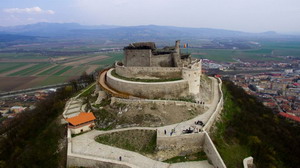 |
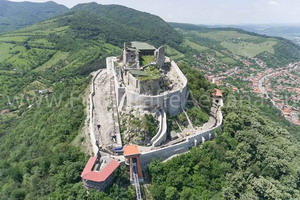 |
Tuesday, July 11th, 2017
08,00 – 09,00 Breakfast
Visit the Sarmisegetuza Regia
13.00 – 14.00 Lunch.
16.00 – 18.00 Meeting with the group from Boita village
19.00 – 21.00 Dinner and dancing with folk ensemble from village
Sarmizegetusa Regia, also Sarmisegetusa, Sarmisegethusa,
Sarmisegethuza, Zarmizegethoúsa or Zermizegethoúse, was the capital
and the most important military, religious and political centre of the Dacians
prior to the wars with the Roman Empire. Erected on top of a 1200 m high mountain,
the fortress, comprising six citadels, was the core of a strategic defensive
system in the Orastie Mountains (in present-day Romania).
Sarmizegetusa Regia should not be confused with Ulpia Traiana Sarmizegetusa,
the Roman capital of Dacia built by Roman Emperor Trajan some 40 km away, which
was not the Dacian capital. Sarmizegetusa Ulpia was discovered earlier, was
known already in the early 1900s, and was initially mistaken for the Dacian
capital, a confusion which led to incorrect conclusions being made regarding
the military history and organization of the Dacians.
https://en.wikipedia.org/wiki/Sarmizegetusa_Regia
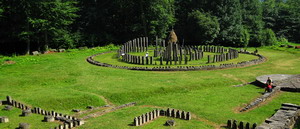 |
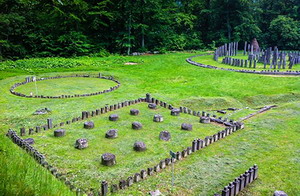 |
Wednesday, July 12th, 2017
08,00 – 09,00 Breakfast
09.00 Departure to Alba Iulia
Visit the Citadel Alba Carolina
13.00 – 14.00 Lunch
16.00 – 18.00 Folk dance workshop
20.00 – 22.00 Dinner and dancing. Show with folk ensemble from Deva
Alba Iulia;
German: Karlsburg or Carlsburg, formerly Weißenburg, Hungarian:Gyulafehérvár,
Latin: Apulum, Ottoman Turkish: Erdel Belgradi or Belgrad-i Erdel) is a city
located on the Mures River in Alba County, Transylvania, Romania, with a population
of 63,536 as of 2011. Since the High Middle Ages, the city has been the seat
of Transylvania's Roman Catholic diocese. Between 1541 and 1690 it was the capital
of the Eastern Hungarian Kingdom and the latter Principality of Transylvania.
Alba Iulia is historically important for Romanians, Hungarians and Transylvanian
Saxons.
https://en.wikipedia.org/wiki/Alba_Iulia
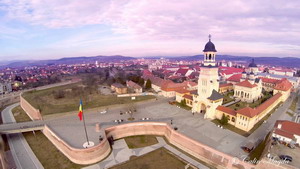 |
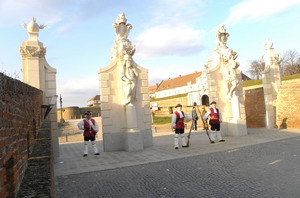 |
Thursday,
July 13th, 2017
07,30 – 08,00 Breakfast
08,00 – Journey back to Timisoara, lunch
16,00 – 19,00 Folk workshop - rehearsal of all the dances that had been
taught
20,00 – 22,00 Dinner - Music and dance with folk
ensemble "Doina Timisului"
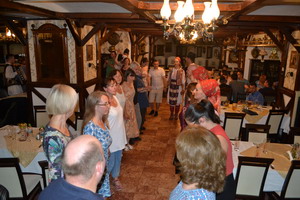 |
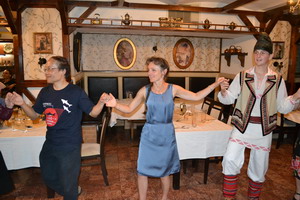 |
Friday, July 14th, 2017
08,30 – 09,00 Breakfast
Departure of the participants
Transfer from the hotel to Timisoara International Airport
Banatfolk organization reserves its right to change the program.